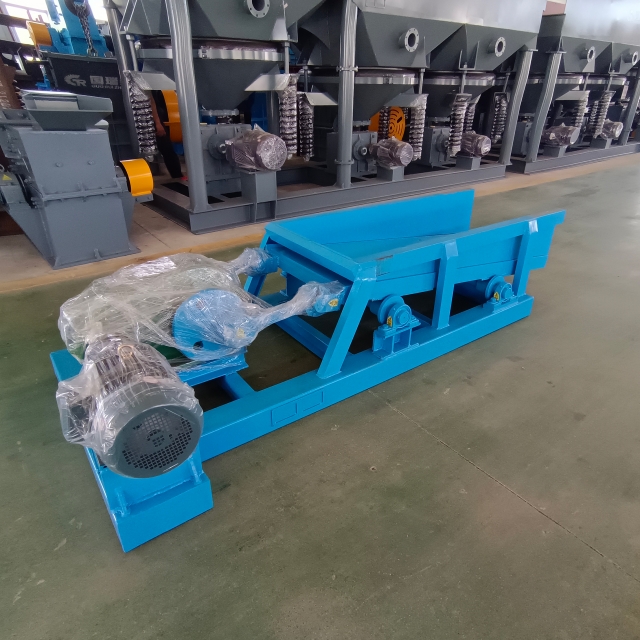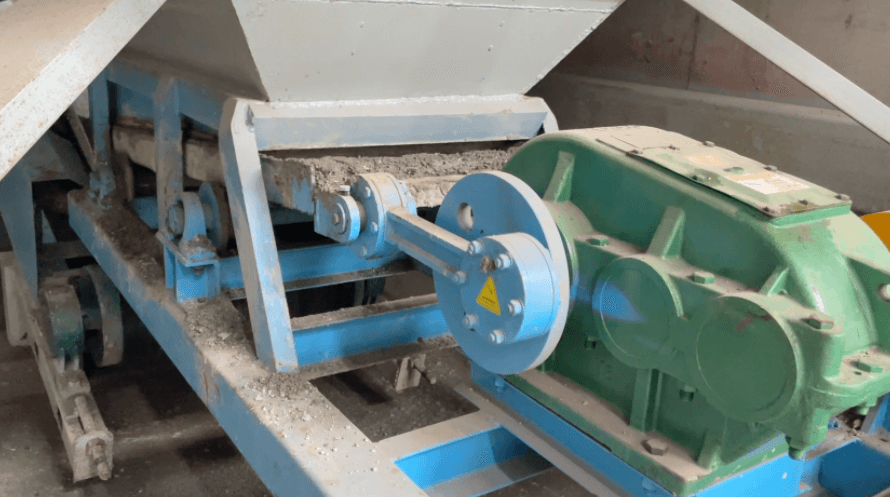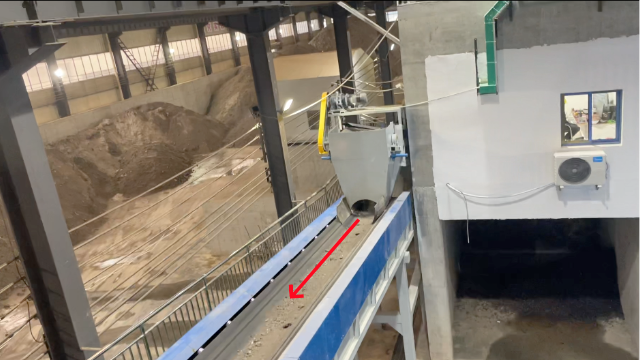Introduction
In the complex world of material handling, the efficiency and reliability of equipment are paramount. Industries ranging from mining to recycling depend heavily on machinery that can handle bulk materials with precision and consistency. Among the myriad of devices used, the Reciprocating Feeder stands out as a crucial component in ensuring smooth operations. This article delves into the significance of reciprocating feeders in material handling, exploring their design, functionality, and the advantages they bring to industrial processes.
A reciprocating feeder is a type of mechanical equipment used to control the flow of bulk materials from storage silos, hoppers, or conveyors to downstream processes. It operates on a simple yet effective mechanism, where a reciprocating plate moves back and forth to feed materials at a controlled rate. The design ensures a consistent and uniform discharge, which is essential in maintaining the balance and efficiency of the entire material handling system.

Key Components and Design Features
The primary components of a reciprocating feeder include the feeder frame, reciprocating plate, drive mechanism, and control system. The feeder frame provides structural support, while the reciprocating plate moves horizontally or at an incline to push materials forward. The drive mechanism, often powered by an electric motor, converts rotational motion into linear reciprocating motion. Advanced feeders may also incorporate variable speed drives and automation controls to adjust feeding rates according to process requirements.
The Role of Reciprocating Feeders in Material Handling
Reciprocating feeders play a pivotal role in various stages of material handling. They ensure a steady supply of materials to crushers, screens, and conveyors, preventing bottlenecks and improving overall productivity. By providing a controlled feed rate, they help in minimizing wear and tear on downstream equipment, reducing maintenance costs and downtime.


Applications Across Industries
The versatility of reciprocating feeders makes them suitable for a wide range of industries. In mining, they handle ores and minerals, regulating the flow to processing plants. In construction, they manage aggregates like sand and gravel. The recycling industry utilizes them for feeding scrap materials, while in agriculture, they handle grains and other bulk commodities. Their ability to handle various material types, from fine powders to large lumps, underscores their importance in material handling systems.
Advantages of Using Reciprocating Feeders
Implementing reciprocating feeders in material handling offers several benefits that enhance operational efficiency and reliability.
Consistent Material Flow
One of the primary advantages is the ability to maintain a consistent material flow. The reciprocating motion ensures that materials are evenly distributed, reducing the likelihood of blockages or surges that can disrupt downstream processes.
Adjustable Feeding Rates
Reciprocating feeders allow for precise control over feeding rates. Operators can adjust the speed and stroke length to match the requirements of specific applications, leading to optimized performance and energy efficiency.
Durability and Low Maintenance
Built to handle heavy loads and abrasive materials, reciprocating feeders are known for their robust construction and durability. Their simple design results in fewer moving parts, translating to lower maintenance needs and longer service life.
Case Studies: Reciprocating Feeders in Action
To illustrate the impact of reciprocating feeders, consider their implementation in a mining operation. A mining company faced challenges with uneven material distribution, leading to frequent downtime. By integrating a Reciprocating Feeder into their system, they achieved a stable feed rate, reduced equipment stress, and increased throughput by 15%.
In another example, a recycling facility dealing with mixed scrap materials required a solution to prevent clogging in their processing equipment. The reciprocating feeder provided a controlled and even feed, enabling the facility to operate continuously with minimal interruptions.
Integration with Other Material Handling Equipment
Reciprocating feeders are often part of a larger material handling ecosystem. They work seamlessly with crushers, screens, conveyors, and separators. For instance, when paired with a Magnetic Separator, they ensure a consistent flow of materials, enhancing the separation efficiency of ferrous metals from the bulk material.
Customization and Scalability
Manufacturers offer reciprocating feeders in various sizes and configurations to meet specific industry needs. Whether it's handling fine particles or large, heavy materials, these feeders can be customized for capacity, feeding rate, and structural design. This scalability makes them suitable for small operations as well as large industrial plants.
Technological Advancements in Reciprocating Feeders
Advancements in technology have led to the development of more sophisticated reciprocating feeders. Modern feeders may include features such as automation, remote monitoring, and integration with plant control systems. These enhancements improve operational efficiency, allowing for real-time adjustments and predictive maintenance.
Energy Efficiency
Energy consumption is a critical consideration in material handling operations. Newer reciprocating feeders are designed with energy-efficient motors and drives, reducing operational costs and environmental impact. Variable frequency drives (VFDs) allow for precise control of motor speed, optimizing energy usage according to demand.
Safety Considerations
Safety is paramount in industrial environments. Reciprocating feeders contribute to a safer workplace by minimizing the need for manual intervention in material handling. Features such as enclosed designs prevent spillage and protect workers from moving parts. Regular maintenance and adherence to safety protocols are essential to ensure the safe operation of these feeders.
Maintenance and Troubleshooting
While reciprocating feeders are known for their durability, regular maintenance is necessary to sustain optimal performance. Maintenance activities include inspecting wear parts, lubrication of moving components, and checking alignment. Early detection of issues such as unusual noises or vibrations can prevent costly breakdowns.
Common Challenges and Solutions
Common challenges with reciprocating feeders include material buildup, component wear, and mechanical failures. Solutions involve implementing routine cleaning schedules, using wear-resistant materials for high-contact areas, and ensuring that the drive mechanism is properly maintained. Staying proactive with maintenance helps in extending the feeder's lifespan and maintains efficiency.
Environmental Impact and Sustainability
In today's industrial landscape, sustainability is a key concern. Reciprocating feeders contribute to environmentally friendly operations by reducing material waste and energy consumption. Their precision in material handling minimizes overfeeding and spillage, which can lead to resource wastage and environmental contamination.
Recycling and Resource Recovery
In recycling applications, reciprocating feeders enable efficient processing of waste materials, facilitating the recovery of valuable resources. By ensuring a consistent feed to sorting and processing equipment, they enhance the efficiency of recycling operations, contributing to resource conservation and waste reduction efforts.
Selecting the Right Reciprocating Feeder
Choosing the appropriate reciprocating feeder requires careful consideration of various factors, including material characteristics, capacity requirements, and operational conditions. Factors such as material density, abrasiveness, moisture content, and particle size influence the feeder's design and specifications.
Consulting with Experts
Engaging with manufacturers and engineers who specialize in material handling equipment is essential. They can provide insights into the best feeder configuration for specific applications. Companies like Ruijie offer a range of reciprocating feeders and can assist in customizing solutions to meet unique operational needs.
Future Trends in Material Handling
The material handling industry is evolving with advancements in technology and shifting industry demands. Automation, Internet of Things (IoT), and data analytics are transforming how material handling equipment operates. Reciprocating feeders are expected to integrate more smart technologies, allowing for enhanced monitoring, predictive maintenance, and improved efficiency.
Emphasis on Automation and Connectivity
Automation reduces the reliance on manual labor and increases safety. Reciprocating feeders equipped with sensors and connectivity can transmit operational data for analysis. This data can be used to optimize performance, schedule maintenance, and reduce downtime.
Conclusion
The Reciprocating Feeder is undeniably a vital component in material handling systems across various industries. Its ability to provide consistent, controlled feeding enhances operational efficiency, reduces equipment wear, and contributes to safer working environments. As industries continue to seek improvements in productivity and sustainability, the reciprocating feeder will remain an essential tool, adapting with technological advancements to meet future challenges.
By understanding its functions, benefits, and applications, businesses can make informed decisions when integrating reciprocating feeders into their operations. Embracing this reliable technology can lead to significant improvements in material handling processes, positioning companies for success in an increasingly competitive and resource-conscious world.










